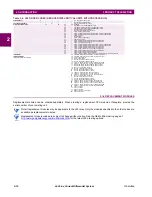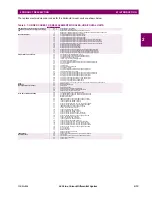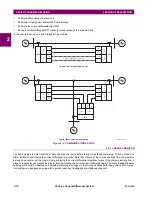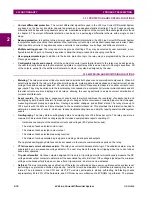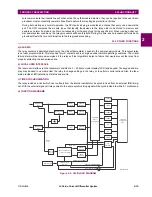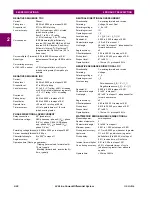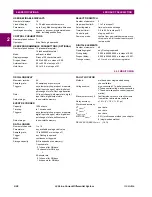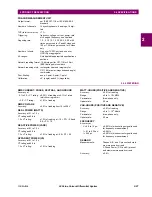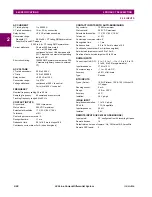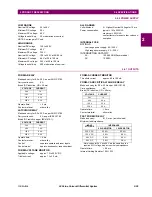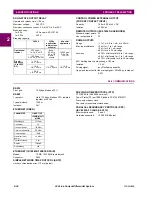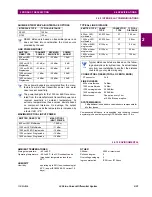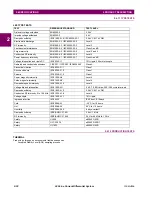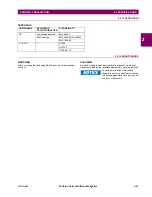
2-18
L90 Line Current Differential System
GE Multilin
2.3 FUNCTIONALITY
2 PRODUCT DESCRIPTION
2
2.3FUNCTIONALITY
2.3.1 PROTECTION AND CONTROL FUNCTIONS
•
Current differential protection
: The current differential algorithms used in the L90 Line Current Differential System
are based on the Fourier transform
phaselet
approach and an adaptive statistical restraint. The L90 uses per-phase
differential at 64 kbps with two phaselets per cycle. A detailed description of the current differential algorithms is found
in chapter 8. The current differential protection can be set in a percentage differential scheme with a single or dual
slope.
•
Backup protection
: In addition to the primary current differential protection, the L90 Line Current Differential System
incorporates backup functions that operate on the local relay current only, such as directional phase overcurrent, direc-
tional neutral overcurrent, negative-sequence overcurrent, undervoltage, overvoltage, and distance protection.
•
Multiple setting groups
: The relay can store six groups of settings. They may be selected by user command, a con-
figurable contact input or a FlexLogic equation to allow the relay to respond to changing conditions.
•
User-programmable logic
: In addition to the built-in protection logic, the relay may be programmed by the user via
FlexLogic equations.
•
Configurable inputs and outputs
: All of the contact converter inputs (digital inputs) to the relay may be assigned by
the user to directly block a protection element, operate an output relay or serve as an input to FlexLogic equations. All
of the outputs, except for the self test critical alarm contacts, may also be assigned by the user.
2.3.2 METERING AND MONITORING FUNCTIONS
•
Metering
: The relay measures all input currents and calculates both phasors and symmetrical components. When AC
potential is applied to the relay via the optional voltage inputs, metering data includes phase and neutral current, phase
voltage, three phase and per phase W, VA, and var, and power factor. Frequency is measured on either current or volt-
age inputs. They may be called onto the local display or accessed via a computer. All terminal current phasors and dif-
ferential currents are also displayed at all relays, allowing the user opportunity to analyze correct polarization of
currents at all terminals.
•
Event records
: The relay has a sequence of events recorder which combines the recording of snapshot data and
oscillography data. Events consist of a broad range of change of state occurrences, including input contact changes,
measuring-element pickup and operation, FlexLogic equation changes, and self-test status. The relay stores up to
1024 events with the date and time stamped to the nearest microsecond. This provides the information needed to
determine a sequence of events, which can reduce troubleshooting time and simplify report generation after system
events.
•
Oscillography
: The relay stores oscillography data at a sampling rate of 64 times per cycle. The relay can store a
maximum of 64 records. Each oscillography file includes a sampled data report consisting of:
–
Instantaneous sample of the selected currents and voltages (if AC potential is used),
–
The status of each selected contact input.
–
The status of each selected contact output.
–
The status of each selected measuring function.
–
The status of various selected logic signals, including virtual inputs and outputs.
The captured oscillography data files can be accessed via the remote communications ports on the relay.
•
CT failure and current unbalance alarm
: The relay has current unbalance alarm logic. The unbalance alarm may be
supervised by a zero-sequence voltage detector. The user may block the relay from tripping when the current unbal-
ance alarm operates.
•
Trip circuit monitor
: On those outputs designed for trip duty, a trip voltage monitor will continuously measure the DC
voltage across output contacts to determine if the associated trip circuit is intact. If the voltage dips below the minimum
voltage or the breaker fails to open or close after a trip command, an alarm can be activated.
•
Self-test
: The most comprehensive self testing of the relay is performed during a power-up. Because the system is not
performing any protection activities at power-up, tests that would be disruptive to protection processing may be per-
formed. The processors in the CPU and all CT/VT modules participate in startup self-testing. Self-testing checks
approximately 85 to 90% of the hardware, and CRC/check-sum verification of all PROMs is performed. The proces-
Summary of Contents for UR Series L90
Page 652: ...A 16 L90 Line Current Differential System GE Multilin A 1 PARAMETER LISTS APPENDIX A A ...
Page 772: ...B 120 L90 Line Current Differential System GE Multilin B 4 MEMORY MAPPING APPENDIX B B ...
Page 802: ...C 30 L90 Line Current Differential System GE Multilin C 7 LOGICAL NODES APPENDIX C C ...
Page 812: ...D 10 L90 Line Current Differential System GE Multilin D 1 IEC 60870 5 104 APPENDIX D D ...
Page 824: ...E 12 L90 Line Current Differential System GE Multilin E 2 DNP POINT LISTS APPENDIX E E ...
Page 834: ...F 10 L90 Line Current Differential System GE Multilin F 3 WARRANTY APPENDIX F F ...
Page 846: ...xii L90 Line Current Differential System GE Multilin INDEX ...









